Food, Nutrition, Health and Diseases Class 5 Notes Science
| Table of contents |

|
| Introduction |

|
| Different Types of Nutrients |

|
| Balanced Diet |

|
| Disease |

|
| 1. Communicable Diseases |

|
| 2. Deficiency Diseases/Non- Communicable Disease |

|
| Tips for Good Health |

|
Introduction
Food is made up of different substances called nutrients. Nutrient is a substance that is needed to keep a living thing alive and to help it to grow. Nutrients are very important for our body because they provide us with energy, protect us from diseases, and help us grow and develop. There are five main types of nutrients in food: carbohydrates, fats, proteins, vitamins, and minerals. Our body needs all these nutrients, but in the right amounts.Different Types of Nutrients
(i) Carbohydrates
Carbohydrates are the main source of energy for our body. Foods like wheat, rice, corn, bread, potatoes, and sugar are rich in carbohydrates.
(ii) Fats
Fats provide even more energy than carbohydrates. Sources of fats include milk, oil, ghee, butter, cheese, and dry fruits. However, eating too much fatty food can lead to obesity.
(iii) Proteins
Proteins are essential for growth and repairing damaged tissues and cells in our body. Foods like milk, paneer, pulses, beans, eggs, and meat are good sources of protein.
(iv) Vitamins and Minerals
Vitamins and minerals are necessary for the normal functioning of our body and help protect us from diseases. Fruits, vegetables, and milk are good sources of vitamins and minerals. For example, Vitamin C keeps our gums healthy, and calcium strengthens our bones and teeth.
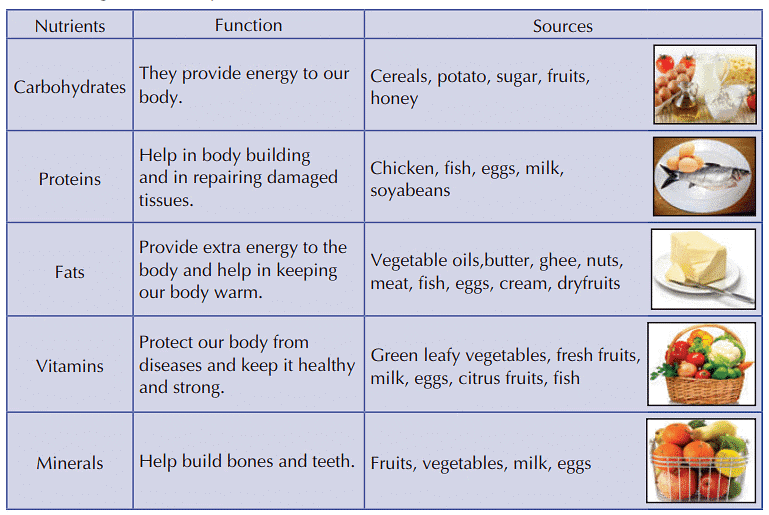
(v) Water and Roughage
In addition to nutrients, our body needs water and roughage. Roughage is the undigested part of plant food, and it helps get rid of waste from our body. Fruits and vegetables are good sources of roughage. Water also helps eliminate waste from our body through urine.
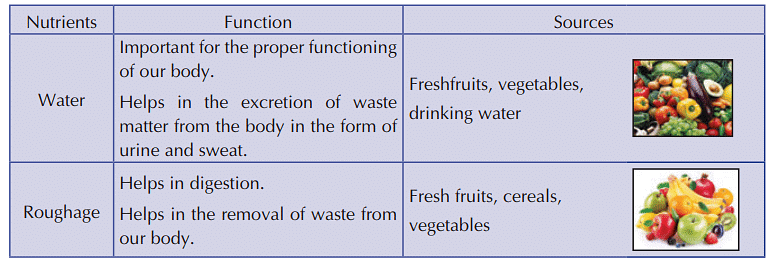
Balanced Diet
- A balanced diet includes all the nutrients, water, and roughage in the right amounts.
- It is important to eat a variety of foods from different food groups to ensure that our body gets all the necessary nutrients.
- A balanced diet helps in maintaining a healthy weight, providing energy, and preventing chronic diseases such as diabetes, heart disease, and obesity.
For example, a balanced diet may include a variety of fruits and vegetables, whole grains, lean proteins, and healthy fats. It is also important to drink enough water and include roughage in the diet for good digestion.
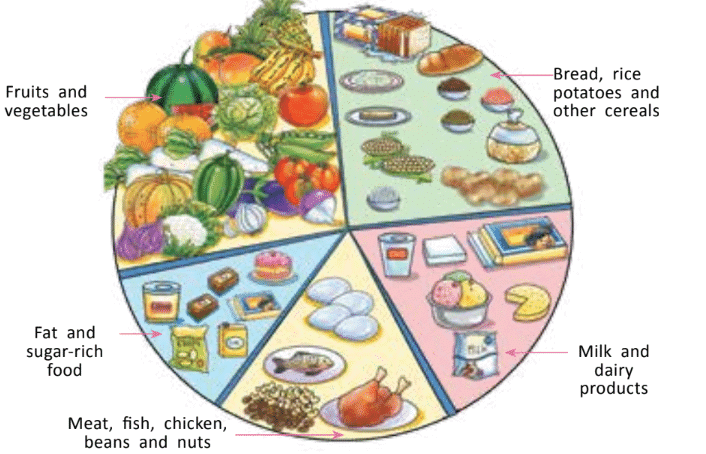 Balanced Diet
Balanced Diet
Disease
The term "disease" comes from "dis-ease," meaning "not at ease" or "uncomfortable." A disease is a condition that disrupts the body's normal functioning. When there is a disturbance in how the body usually works, it is termed a disease or illness.
Types of Diseases
1. Communicable Diseases
- Communicable diseases, also known as infectious diseases, are illnesses that can be transmitted from an infected person to a healthy person, either directly or indirectly.
- These diseases are caused by germs called pathogens, which include viruses, bacteria, fungi, protozoa, and worms.
- Pathogens are so small that they can only be seen under a microscope, which is why they are referred to as microorganisms or microbes.
2. Non-communicable Diseases
- Non-communicable diseases are illnesses that cannot be spread from one person to another.
- These diseases are typically caused by a deficiency of certain vitamins or nutrients, or by the malfunctioning of specific body functions or organs.
1. Communicable Diseases
(A) Pathogens causing Diseases
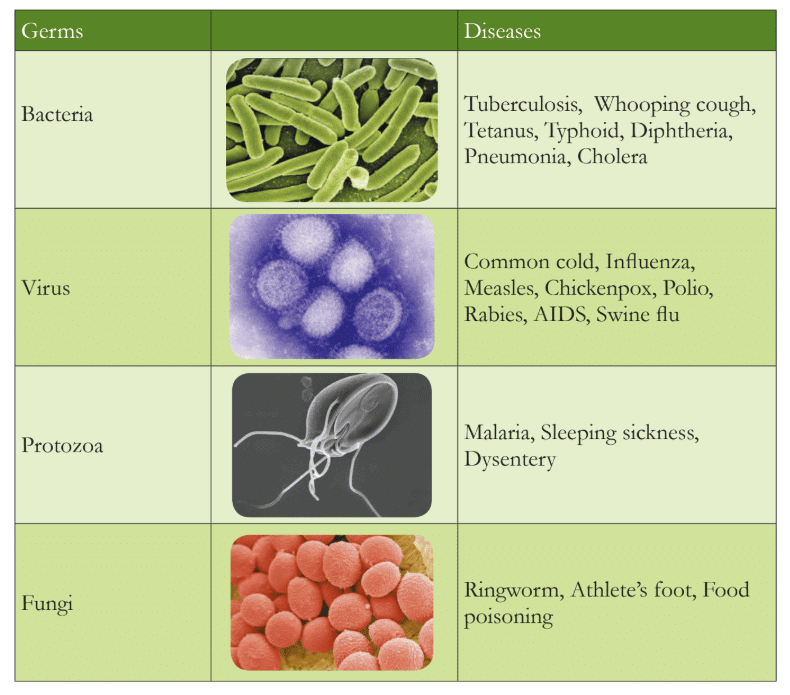
(B) Spread of Communicable Diseases
Communicable diseases can spread through an infected person or through various modes. We can divide these modes into two types for our study.
1. Direct Mode
Diseases through direct mode can happen in two ways.
(i)Through Direct Contact: Healthy person directly comes in contact with a person suffering from the disease. Diseases can also spread through articles like towels, handkerchief and utensils used by the sick person. Diseases like chickenpox, measles and ringworm spread through direct contact.
(ii)Through Cuts and Wounds in the Skin: Germs can enter the body through cuts and wounds on skin and cause infection. Example, tetanus. Sometimes, disease can also spread from mother to the child during childbirth.
2. Indirect Mode
Infectious agents spread from one person to another through a medium. These medium can be air, food and water, vectors. (insects and other animals)
(i) Through Air: When a sick person suffering from common cold, tuberculosis, diphtheria or influenza coughs or sneezes, germs are released into the air. A healthy person inhaling this air may suffer from the disease as the discharge from the nose and the mouth contains disease-causing germs.
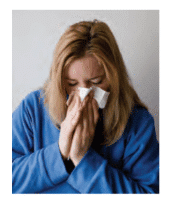 A Person Suffering from Common Cold(ii)Through Infected Food and Water: Many germs are transmitted through infected food and water. Organisms like houseflies and cockroaches carry germs on their bodies from dirty places like garbage and sewer. We call these organisms the carriers of germs. When we leave our food and water uncovered, these carriers sit on it and leave the germs there. Now we call this food and water contaminated. Handling food and water with dirty hand too can contaminate food and water. When we consume this contaminated food or water the germs enter our body and make us ill. Diseases like typhoid, jaundice and food poisoning are caused by eating contaminated food or drinking polluted water.
A Person Suffering from Common Cold(ii)Through Infected Food and Water: Many germs are transmitted through infected food and water. Organisms like houseflies and cockroaches carry germs on their bodies from dirty places like garbage and sewer. We call these organisms the carriers of germs. When we leave our food and water uncovered, these carriers sit on it and leave the germs there. Now we call this food and water contaminated. Handling food and water with dirty hand too can contaminate food and water. When we consume this contaminated food or water the germs enter our body and make us ill. Diseases like typhoid, jaundice and food poisoning are caused by eating contaminated food or drinking polluted water.
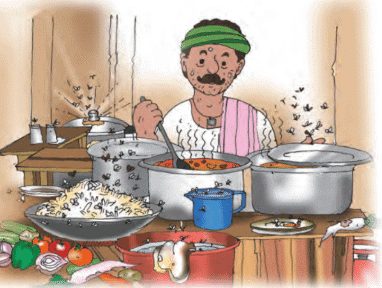 Diseases spread through unhygienic food3. Through Vectors. Through Insects: Some of the microorganisms are carried by some insects and animals known as vectors. Mosquito and housefly are most common vectors. When an insect like mosquito bites an infected person, the germs reaches the body of the mosquito. This does not harm the mosquito but when this mosquito bites another healthy person, the germs get transferred into the blood of the healthy person and infect him.
Diseases spread through unhygienic food3. Through Vectors. Through Insects: Some of the microorganisms are carried by some insects and animals known as vectors. Mosquito and housefly are most common vectors. When an insect like mosquito bites an infected person, the germs reaches the body of the mosquito. This does not harm the mosquito but when this mosquito bites another healthy person, the germs get transferred into the blood of the healthy person and infect him.
(C) How do pathogens spread Diseases?
- Through Water: Water can be a carrier of diseases such as cholera and typhoid. These diseases can spread when contaminated water is consumed.
- Through Air: Airborne diseases like flu, cough, and cold can spread when an infected person sneezes or coughs, releasing pathogens into the air.
- Through Mosquitoes: Diseases like malaria and dengue are transmitted by mosquitoes. Malaria is caused by a protozoan carried by the female Anopheles mosquito, while dengue is transmitted by the Aedes mosquito infected with the dengue virus.
 Spread of Disease through Mosquito
Spread of Disease through Mosquito
- Through Animal Bites: Some animals carry germs that can cause diseases. For example, dogs carry the rabies virus, and their bite can transmit this fatal disease. The Nipah virus is another example, where certain animals act as carriers of the virus.
(D) Ways to Prevent Communicable Diseases
- Personal Cleanliness: Regular bathing with soap or shampoo is essential for personal hygiene.
- Hand Washing: Hands should be washed with soap and water before and after eating, using restrooms, touching animals, sneezing, or coughing.
- Covering Coughs and Sneezes: Using a tissue or handkerchief to cover the nose while coughing or sneezing helps prevent the spread of germs. Used tissues should be disposed of properly.
- Avoiding Shared Items: Items like towels, clothes, spectacles, and eye drops should not be shared with individuals suffering from communicable diseases.
- Eliminating Stagnant Water: Stagnant water around homes or in coolers should be avoided as it promotes mosquito breeding.
- Covered Dustbins: Keeping dustbins covered helps maintain hygiene.
- Covering Food and Water: Drinking water and food items should be kept covered to prevent contamination. Uncovered food items should not be consumed.
- Avoiding Dirty Public Bathrooms: Using clean bathrooms in public places helps prevent the spread of diseases.
- Spraying Disinfectants and Insecticides: Regular spraying of disinfectants and insecticides in homes helps maintain hygiene.
Important Note: Vaccination
- Vaccination is a method to prevent certain communicable diseases such as polio, tetanus, typhoid, and measles.
- Vaccines contain dead or weakened disease-causing germs and are either injected or given orally.
- When vaccines enter the body, they stimulate the production of antibodies that protect against specific diseases.
- Vaccines are administered at specific ages for different diseases to ensure effective immunity.
2. Deficiency Diseases/Non- Communicable Disease
Diseases which do not spread from one person to another are called non-communicable diseases. Some non-communicable diseases are present at the time of birth and some are caused due to the lack of nutrients in our body. Some of them are caused by pollution or dangerous chemicals. Asthma, beriberi, goitre, kwashiorkor, marasmus, etc, are some examples of non-communicable diseases.
Deficiency diseases
Diseases caused due to the lack of nutrients in our body are called deficiency diseases.1. Some diseases caused due to the lack of vitamins in our body are:
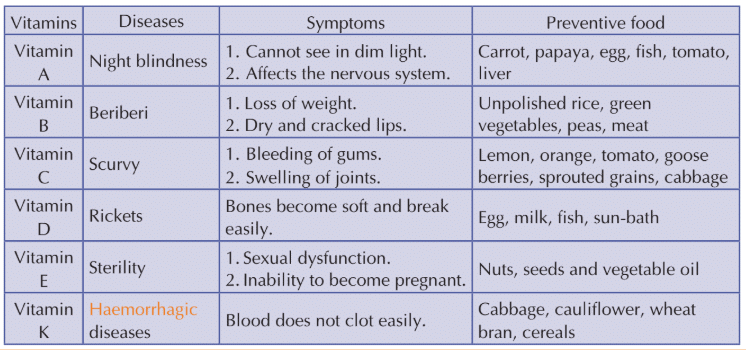
2. Some diseases caused due to lack of minerals:

Malnutrition
The deficiency of proteins and carbohydrates in our body causes malnutrition. Malnutrition due to the deficiency of proteins is called Protein Calorie Malnutrition(PCM).
1. Some diseases caused due to protein calorie malnutrition:

2. Diseases caused due to carbohydrate malnutrition:

Tips for Good Health
- Wash your hands regularly with soap and water to remove dirt and germs. This helps prevent diseases, skin infections, and allergies.
- Brush your teeth twice a day and clean your tongue with a tongue cleaner to maintain oral hygiene.
- Avoid spitting in public places to keep the environment clean.
- Exercise regularly to tone your muscles and rejuvenate your body.
- Get enough sleep to relax your muscles and repair body cells.
- Eat a healthy and balanced diet to provide your body with the necessary nutrients.
|
42 videos|343 docs|45 tests
|
FAQs on Food, Nutrition, Health and Diseases Class 5 Notes Science
| 1. What are the different types of nutrients essential for our body? |  |
| 2. What constitutes a balanced diet? |  |
| 3. What are communicable diseases, and how can they be prevented? |  |
| 4. What are deficiency diseases, and what causes them? |  |
| 5. What are some tips for maintaining good health? |  |





















